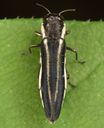Agrilini
Agrilini
Classification
- Phylum: Arthropoda
- Subphylum: Hexapoda
- Class: Insecta
- Order: Coleoptera
- Suborder: Polyphaga
- Superfamily: Buprestoidea
- Family: Buprestidae
- Subfamily: Agrilinae
- Tribe: Agrilini
Pronunciation
How to pronounce Agrilini: //ˌæɡrɪˈlaɪnɪ//
These audio files are automatically generated. While they are not always 100% accurate, they are a good starting point.
Images






Summary
Agrilini is a tribe of metallic wood-boring beetles with significant biodiversity both regionally and globally, with several genera primarily represented by the genus Agrilus.
Physical Characteristics
Metallic coloration with a hard, shiny exterior, typical of wood-boring beetles.
Identification Tips
Look for elongated bodies and a metallic sheen in coloration. Check for the characteristic rounded or elongate shape associated with wood-boring beetles.
Habitat
Primarily forested areas where they can be found boring into wood of hardwood and softwood trees.
Distribution
Found throughout North America; globally present with peak diversity in the Neotropics.
Diet
Larvae primarily feed on the wood of trees; adults may feed on foliage and flowers.
Life Cycle
Life cycle includes egg, larval, pupal, and adult stages, with larvae developing within wood.
Reproduction
Typically reproduce sexually with females laying eggs in or on wood suitable for larval development.
Predators
Birds, small mammals, and other insect predators may feed on adult beetles and larvae.
Ecosystem Role
Important decomposers; larvae help in the breakdown of dead trees, contributing to nutrient cycling.
Economic Impact
Some species are considered pests as they can damage timber and living trees.
Collecting Methods
- Light traps
- Hand collection from infested wood
- Pitfall traps
Preservation Methods
- Ethanol
- Pinning
- Freezing
Evolution
Part of the diverse family Buprestidae, known for their vivid coloration and wood-boring habits, they have evolved to exploit wood as a resource.
Similar Taxa
- Buprestidae
- Chrysobothridae
Misconceptions
Often mistaken for other types of beetles due to their metallic appearance; some may confuse them with pests that are more harmful to agriculture.
Tags
- beetles
- Agrilini
- metallic wood-borers
- Buprestidae
- entomology